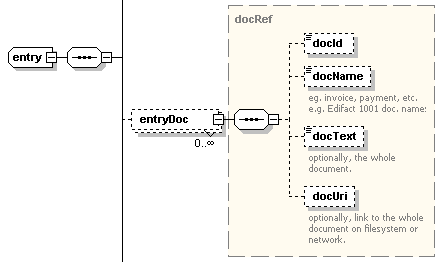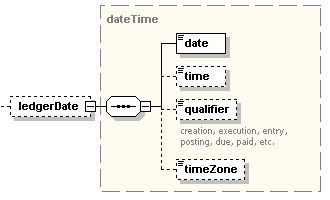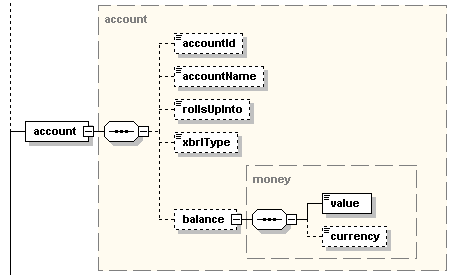| |
arapXML
ledger element
|
Field
description / usage
|
Interface
behavior
|
|
Synonyms |
| 1 | ledger
(optional)
OMG GL: ledger_name
OAGIS: GLENTITYS | The
ledger element uses "code" object above. The "codeValue"
within "code" uniquely identifies the ASP, system, host or software which created this arapXML instance, globally, and furthermore, if that system contains multiple ledgers,
getRecordUri uniquely identifies the source ledger within that collection of ledgers. Syntax is URI
(RFC 2396) (note 2).
An implied contract exists that drillback into the transactions within this arapXML instance may be provided by the host ledger, by reference to
this fromLedgerURI plus the transactionId element.
See originalLedgerUri below.
"codeText" in this
context is the name or alias of the source ledger identified in the "getRecordUri"element
of the "code" object. Usually a mnemonic or full name of
the legal entity. The ledgerName is the name of the ledger or subledger (at
the user interface level) to which this transaction belongs.
|
(system)
The initiator populates this field with
its own ledger name or code.
The recipient accepts the
source ledger name or code from the ledger
element, and
typically stores it in the database field associated with the originalLedger
element below.
|
| 2 |
ledgerDate
(optional) |
Uses
the arapXML date object above.
|
(system)
|
| 3 |
batchDoc
(optional)
|
Uses
the docRef structure above to convey any document about the transactionSet.
|
|
| 4 | controlTotal
(optional)
- |
Uses the
accountDetails structure above to convey 1 or more control totals for
accounts or groups of accounts in the system.
|
|
| 5 | transactions
(required)
- |
The
transactions (whew)
|
|
| |
arapXML
ledger element
|
Field
description / usage
|
Interface
behavior
|
|
Synonyms |
| 1 | transactionId
(optional)
OMG GL: trans_id
OAGIS: JEID | Uniquely identifies this ledger transaction (header+set of rows) within the source ledger, subledger, or purchasing or sales module etc. identified by ledgerUri element.
transactionId is not required in arapXML interactions because some GLs don't use id's, and others use only row id's. But if transactionId is used, the source ledger shall provide a transactionId which, together with ledgerUri, provides a globally unique identifier for this transaction."
| (supported)
This is the Ledger's primary key (index).
When sending
the Ledger
will
provide transactionId. When receiving a batch, the Ledger
captures this field into originalTransactionId below, and creates a new
value for transactionId internally.
|
| 2 |
transactionDocRef
(optional)
OMG GL: voucher_ref
|
General purpose reference to one or more source documents for audit trail. Uses the arapXML DocRef
type
|
|
| 3 |
transactionDate
(optional)
OMG GL: voucher_date
OAGIS: DATETIME
(DOCUMENT) |
Date and time
pairs for any of a large number of adjectives such as legal transaction recognition,
due date, posting date, accounting period, etc.
Uses the arapXML GLdatetime type, composed of three elements: a date in ISO 8601 format, and an optional time also in ISO 8601
format and a qualifier. In arapXML, the default formats "yyyy-mm-dd" and "hh:mm:ss" should be used in absence of prior agreement between parties.
By default valid qualifiers will
include transaction execution, posting, period and ..TBD
|
|
| 4 |
transactionPostDate
(optional)
OMG GL: act_trans_date |
System date the
transaction was posted if postedStatus is true. Otherwise, future date requested by
originator, subledger, etc. to
post this transaction.
|
|
| 5 | period
(optional)
OMG GL: period_id | accounting period
|
|
| 6 |
transactionDescription
(optional)
OMG ARAP:trans_description
OAGIS: DESCRIPTN |
explanation text, memo, string
etc. at header level.
|
|
| 7 | originalLedgerUri
(optional)
| Uri of
the originator of the transaction or which provides drillback or audit
trail.
|
|
| 8 | originalTransactionId
(optional) | Unique
id of this transaction on the original system, for drillback or audit trail.
|
|
| 9 |
groupId
(optional)
OMG ARAP:group_id
|
associates this transaction
within any related transaction group or set of transactions within an ebXML transaction pattern,
CPA, or other choreography. for example, associates the PO with any
fulfillment, invoice and/or settlement that may occur at a later time or
separate posting.
|
|
| 11 |
transactionType
(optional) | values
A,B,T, or F (Actual, Budget, Forecast,
TaxAdjustment)
(for tax differences use multiple types and rows)
|
|
| 12 |
journalType
(optional) | Journal
type e.g. sales, purch, cash disbursement etc.
|
|
| 13 |
transactionBatchId
(optional) |
associates this
TransactionId with a batch.
A batch is a collection of transactions within one or more arapXML files, to
be managed together for purposes such as posting, approval, backup etc.
|
|
| 14 | isPosted
(optional)
OMG ARAP:posted_status
| zero if false (not posted); 1 if
true (posted) Enables unposted transaction batches from internal or
external (untrusted) sources to be appended to the primary GL or subledgers
such as AR/AP systems.
|
|
| 15 | isSummary
(optional)
| zero if false (not
summary); 1 if
true (summary) Enables summary reports or posting from one ledger or
system to another
|
|
| |
arapXML
ledger element
|
Field
description / usage
|
Interface
behavior
|
|
Synonyms |
| 1 | transactionId
trans_id
|
uniquely identifies this transaction (set of rows)(FK)(equal
to transactionId in the arapXML header element)
|
|
| 2 | entryId
entry_id
|
uniquely identifies this row (e.g. line of
journal entry)
|
|
| 3 |
entryDate
entry_date
DATETIME
(ACCOUNTING)
|
Date and time pairs for
any of a large number of adjectives such as legal transaction recognition,
due date, posting date, accounting period, etc.
Uses the arapXML GLdatetime type, composed of three elements: a date in ISO 8601 format, and an optional time also in ISO 8601
format and a qualifier. In arapXML, the default formats "yyyy-mm-dd" and
"hh:mm:ss" should be used in absence of prior agreement between parties.
By default valid qualifiers will
include transaction execution, posting, period and ..TBD
|
|
| 4 |
entryType
entry_type
|
sales journal, purchase journal,
cash receipts journal, etc. (values constrained by arapXML schema)
|
|
| 5 |
accountCode
acc_id
|
the chart of accounts account code for the transaction
if segmented codes are not used.
|
|
| 6 |
accountName |
name of the account in chart of
accounts
|
|
| 7 | xbrlType
xbrl_type
(of Account)
|
classification of this row for GAAP reporting.
|
|
| 8 | amount
amount
|
any numeric value consistent with
your functional currency.
In ArapXML, positive numbers are debits, and negative numbers are credits respectively.
Alternatively, the debitOrCredit indicator is used. The
determination is made once at the creation of the ledger, and maintained in
its ledger definition. See also debitOrCredit documentation below.
|
|
| 9 | debitOrCredit
dr_cr
|
valid values are one of
the following:
"D", "C", "d", or
"c".
Note that applying the debit/credit indicator
to an entry line, or applying the +/- sign to the numeric amount of the
entry, is completely independent of the normal sign that may be
associated with an account code (e.g. sales are normally credits but are
almost always displayed as positive numbers in reports) (In ArapXML,
positive numbers are debits, and negative numbers are credits respectively.)
ArapXML requires that either the debitOrCredit indicator or +/- sign is applied to every entry line, independently of the normal sign of account codes. The management of signs in reports and query responses to users is a
responsibility of report and GUI designers.
|
|
| 10 |
currency |
ISO 4217 currency code applicable
to Amount
|
|
| 11 |
originalAmount
orig_amount
|
any numeric value consistent with the
currency in CurrencyForeign below
|
|
| 13 |
entryDescription
description
|
explanation text or memo string etc.
|
|
| 14 | entryDoc
voucher_ref
(of Entry)
|
source doc. number or index, etc.
(supports systems which carry doc. references for both header and row)
|
|
| 15 | ledgerUser
user_id
|
authenticated user
who recorded this row of this transaction in this system, i.e. the
system to which entryId belongs.
|
|
| 16 |
costCenter
cost_center_id
|
any accumulator supporting
grouping of expenses and costs.
|
|
| 17 |
geographic |
Top level geographic code or area
the transaction is associated with.
|
|
| 19 | taxType
tax_type
|
taxable scheme, rate, category, etc.
(for multiple tax entries use multiple rows)
|
|
| 20 |
negotiationState
entry_negotiation_state
|
string such as "offer",
"draft", "acceptance", "fulfilled",
"settled" etc. appropriate for this transaction pattern or ebXML
CPA. Indicates the level of completion or negotiation of this
transaction row only.
|
|
| 27 |
partysUser
party_user_id |
UserId
of the authenticated member of the named recipient, who
posts acceptance or agreement. |
|
| 31 | party
party_id
|
QName (namespace:id) uniquely identifies the reciprocal party to this
row of this transaction
|
|
| 38 |
orgUnit |
organization
hierarchy within the legal Entity
|
|
| 41 |
employee |
employee associated
with this transaction, revenue, expense etc. for HR, incentive or
accountability.
|
|
| 44 | dueDate
due_date
|
"YYYY-MM-DD" date
the asset/liability is/was due
|
|
| 45 | settlementMethod
settlement_method
|
How or by what bank, settlement
agent, etc. the asset/liability is/was settled (a
Qualified
name (Qname)
|
|
| 51 |
productOrService
product_id
|
Item, SKU or other unique
identifier for the product or service.. Qname (Qualified
name) include catalog or product namespace.
|
|
| 53 |
quantity |
Quantity of the above product or
item or service.
|
|
| 57 |
partysDoc
party_voucher_ref
|
3rd party's invoice
number, po number, etc.
|
|
| 58 |
fund |
a legal or budgetary unit such as
within municipal or not-for-profit ledgers
|
|
| 60 |
project
project_id
|
1st level of project code
|
|
| 62 |
job |
uniquely identifies the job, project, etc.
|
|



